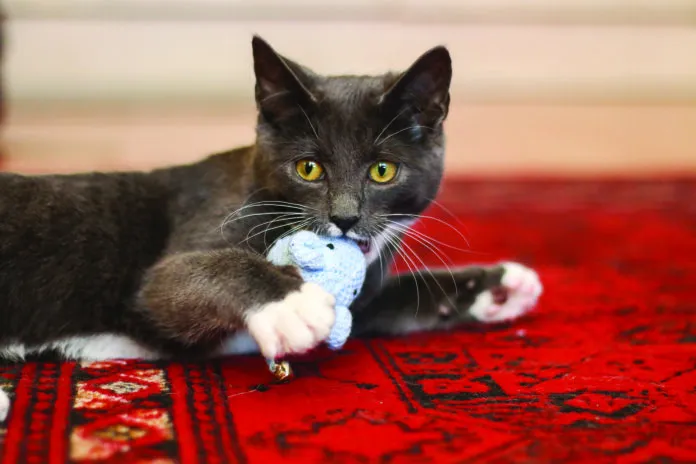My cats cry while carrying their toys
Q: We’ve had our two cats for five years. After a couple of years, the older one, a female named Autumn, started to pick up a toy — a super-small ball — and walk around the house crying while carrying it. Now our younger cat, a male we call Cole, has started doing it with a squeaky mouse. The first time we heard it we thought Autumn was sick, but everything checked out fine. We know Cole is okay, too, but we’re at a loss to explain why cats would do this. And each cat has done it continuously since starting the habit. Any ideas?
Sue Cather
Alamogordo, New Mexico
Dear Ms. Cather,
A: The activity is not as unusual as you might think. Behaviorists conjecture that one reason for it may be that a cat connects with his or her toy as if it’s their child. Your cats could be “bonding” with their toys and deriving comfort from the so-called interaction. Also, a cat who has had kittens may bring prey to the nest to let her babies practice hunting. She will announce the arrival of the prey by holding it in her mouth while meowing.
It’s also possible that your cats are pleased with their plunder. Even in the wild, a cat might cry with his prey in his mouth after having caught it. It’s his way of expressing pleasure about his catch. (This might be the more likely explanation for your male pet.)
Finally, it could be that your cats are seeking your attention and want you to start playing with them: “Look what I have!”
Do keep in mind that cats like to catch their toys and hold them, not just chase them. Thus, while moving a beam of light around the wall or pulling a feather along the floor as your cat goes after it might be fun, sometimes you should engage in games that allow your pet to actually attack the object. The hunt without “bagging the prize” can prove frustrating. Thus, it’s good that you have toys on hand that your pets can actually grab hold of.
What about milk that’s lactose-free?
Q: I have read that you shouldn’t give your cat milk because it contains lactose, which they don’t tolerate well. Can they have lactose-free milk that some people drink? It would solve that problem!
Patty Betts
Novi, Michigan
Dear Ms. Betts,
A: You raise an interesting question. Most adult cats, just like adults of other mammalian species, do have some degree of lactose intolerance. The standard cow’s milk we pour into our pets’ bowls simply has more lactose than a lot of cats can digest easily or comfortably. If that were the only concern, lactose-free milk would be a great alternative for milk-loving felines who experience diarrhea, bloating, and flatulence when they drink regular milk. But there’s more.
Cow’s milk also contains more casein — the main protein in milk — than many cats can digest. Then, too, milk just doesn’t fit very easily into a feline’s nutritious diet. A 12-pound cat should consume no more than about 250 calories a day, and only 10 percent of those calories — 25 — should come from treats, which unlike commercially available cat food do not have the balanced nutrition cats need to thrive.
Milk is one of those unbalanced treats, and 25 calories of the beverage doesn’t go very far. Just two fluid ounces of skim milk contain about 23 calories. An ounce and a half of whole milk has 28 calories. And many cats also eat other treats during the day, which would bring down the number of calories in a cat’s diet that should be contributed by milk.
The bottom line: Sure, go ahead and give your cat a little lactose-free milk. But for optimum health, servings should be limited to a couple of tablespoons or so. Two tablespoons make one fluid ounce.




